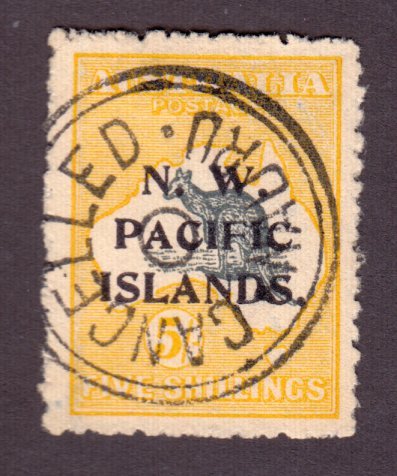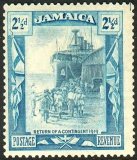
Discussion - Member to Member Sales - Research Center

Discussion - Member to Member Sales - Research Center

What do you think of this stamp and what is your favorite stamp with different colors.
Mike
http://i39.photobucket.com/albums/e195/lpayette/ku.jpg

Login to Like
this post
Mike, I hate to tell you, but the stamp actually is only a two-color stamp. I think the multi-color effect is caused by a refraction of the light when the image was made. Here is the true appearance of the stamp:

It is still a nice stamp, however.

1 Member
likes this post.
Login to Like.
Michael,
Oh yeah, thanks a lot for spoiling my whole life!!!! Now I'm going to have to buy that stamp and then sue the seller for false advertisement. OK, OK, maybe it's not so bad after all and I think I will keep that scan, mine not yours, as a momento of a very unique stamp. I still like the color combinations that the commonwealth uses for their stamps.
Just kidding about spoiling my whole life, of course. Plus, you didn't leave a comment about your favorite colors of stamps. 
Mike

Login to Like
this post
Michael, I always thought that a two-color stamp was still a multi-color stamp. Am I wrong?

Login to Like
this post
Peter, in a way, I guess you are correct. More than one is a multiple, thus "multi". However, I believe as far as the Scott catalogs go, a stamp is listed as "multicolored" if it has more than three colors.

Login to Like
this post
Mike, I don't know that I have favorite colors of stamps. I like stamps that are well designed and color coordinated, but that covers the entire spectrum.

Login to Like
this post
There some earlier KUT stamps with a silhouette of a lion I really like, an example is:

Josh

Login to Like
this post
"Mono-color", "bi-color" or "multi-color". Yes, it can be confusing given that there are many sources, philatelic and otherwise, that do not agree on those terms.
My take on it is that a mono-color stamp has only a single color, such as blue. That term probably has the most universal agreement on its definition.
A multi-color stamp, by the literal definition, has more than one color. So, a stamp with blue and red could indeed be considered a multi-color stamp.
But that begs the question of what is a bi-color stamp? Would it be more appropriate, therefore, to call the blue and red stamp bi-color, i.e., 2 colors, and then more than 2 colors would be considered a multi-color stamp?
To add a bit more confusion to the mix, I’ve seen auction catalogs describe stamps as bi-color when a single color such as blue was used to print the stamp on yellow paper. I believe that stretches the definition of bi-color too far. Such a stamp is actually a mono-color stamp printed on colored paper.
Ah, the joys of stamp collecting!

Login to Like
this post
 I think the brighter colour on the KUT stamp might have happened when I was scanning at 150 instead of 200,
I think the brighter colour on the KUT stamp might have happened when I was scanning at 150 instead of 200,
I usually scan at 200,but had scanned some documents at 150 and forgot to change it back to 200 
But it is a pretty stamp.
Josh - love that stamp 
Lee

1 Member
likes this post.
Login to Like.
Here's a single colored stamp that I think has a nice and unusual color:


Login to Like
this post

04:44:20pm
The divisions between colors we were taught in school; Primary or Secondary and so on, are purely an arbitrary segmentation of what is actually a stead range of wave lengths.
What I enjoy is that Chinese and Japanese colors are often just slightly off what I would expect. This must be cultural with he precise separation point they are taught a tiny bit different from what western society accepts.
Someone else must have noticed this and written an explanation of how this happens.

Login to Like
this post
Wow  Such colors you have on that stamp Lee
Such colors you have on that stamp Lee 
These 3 stamps are the favourite multicolored, monocolored and bicolored stamps in my possession 


Login to Like
this post

I have just seen this very nice stamp from KUT was amazed at the colors. British colors have always been a favorite of mine anyway, but this one is so different than any other that I just wanted to share it with everyone. There are tons of stamps that have many colors on them, but usually they depict a scene or more than one subject on the stamp, while this stamp is another of the Queen. Long live the Queen!!!
What do you think of this stamp and what is your favorite stamp with different colors.
Mike
http://i39.photobucket.com/albums/e195/lpayette/ku.jpg

Login to Like
this post

re: British stamp colors
Mike, I hate to tell you, but the stamp actually is only a two-color stamp. I think the multi-color effect is caused by a refraction of the light when the image was made. Here is the true appearance of the stamp:

It is still a nice stamp, however.

1 Member
likes this post.
Login to Like.

re: British stamp colors
Michael,
Oh yeah, thanks a lot for spoiling my whole life!!!! Now I'm going to have to buy that stamp and then sue the seller for false advertisement. OK, OK, maybe it's not so bad after all and I think I will keep that scan, mine not yours, as a momento of a very unique stamp. I still like the color combinations that the commonwealth uses for their stamps.
Just kidding about spoiling my whole life, of course. Plus, you didn't leave a comment about your favorite colors of stamps. 
Mike

Login to Like
this post
05:13:20pm
re: British stamp colors
Michael, I always thought that a two-color stamp was still a multi-color stamp. Am I wrong?

Login to Like
this post

re: British stamp colors
Peter, in a way, I guess you are correct. More than one is a multiple, thus "multi". However, I believe as far as the Scott catalogs go, a stamp is listed as "multicolored" if it has more than three colors.

Login to Like
this post

re: British stamp colors
Mike, I don't know that I have favorite colors of stamps. I like stamps that are well designed and color coordinated, but that covers the entire spectrum.

Login to Like
this post

re: British stamp colors
There some earlier KUT stamps with a silhouette of a lion I really like, an example is:

Josh

Login to Like
this post

re: British stamp colors
"Mono-color", "bi-color" or "multi-color". Yes, it can be confusing given that there are many sources, philatelic and otherwise, that do not agree on those terms.
My take on it is that a mono-color stamp has only a single color, such as blue. That term probably has the most universal agreement on its definition.
A multi-color stamp, by the literal definition, has more than one color. So, a stamp with blue and red could indeed be considered a multi-color stamp.
But that begs the question of what is a bi-color stamp? Would it be more appropriate, therefore, to call the blue and red stamp bi-color, i.e., 2 colors, and then more than 2 colors would be considered a multi-color stamp?
To add a bit more confusion to the mix, I’ve seen auction catalogs describe stamps as bi-color when a single color such as blue was used to print the stamp on yellow paper. I believe that stretches the definition of bi-color too far. Such a stamp is actually a mono-color stamp printed on colored paper.
Ah, the joys of stamp collecting!

Login to Like
this post

re: British stamp colors
 I think the brighter colour on the KUT stamp might have happened when I was scanning at 150 instead of 200,
I think the brighter colour on the KUT stamp might have happened when I was scanning at 150 instead of 200,
I usually scan at 200,but had scanned some documents at 150 and forgot to change it back to 200 
But it is a pretty stamp.
Josh - love that stamp 
Lee

1 Member
likes this post.
Login to Like.

re: British stamp colors
Here's a single colored stamp that I think has a nice and unusual color:


Login to Like
this post
Silence in the face of adversity is the father of complicity and collusion, the first cousins of conspiracy..
23 Dec 2012
04:44:20pm
re: British stamp colors
The divisions between colors we were taught in school; Primary or Secondary and so on, are purely an arbitrary segmentation of what is actually a stead range of wave lengths.
What I enjoy is that Chinese and Japanese colors are often just slightly off what I would expect. This must be cultural with he precise separation point they are taught a tiny bit different from what western society accepts.
Someone else must have noticed this and written an explanation of how this happens.

Login to Like
this post

re: British stamp colors
Wow  Such colors you have on that stamp Lee
Such colors you have on that stamp Lee 
These 3 stamps are the favourite multicolored, monocolored and bicolored stamps in my possession 


Login to Like
this post

